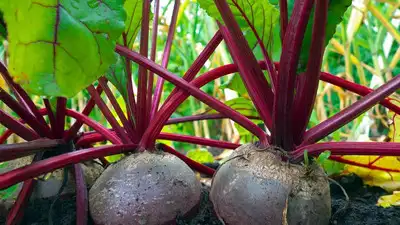ARTICLE AD BOX

Beets are a gardener’s delight, vibrant, earthy, and packed with nutrition, but they can be surprisingly tricky to grow. From stunted bulbs and overcrowded seedlings to split roots and pest damage, even experienced growers face challenges when cultivating this colourful root vegetable.
The good news is that most beet-growing problems stem from a few common mistakes, many of which are easy to fix with the right approach. By paying attention to soil preparation, watering, spacing, and harvest timing, you can avoid disappointment and enjoy a steady supply of sweet, tender beets and nutritious greens straight from your garden.
10 mistakes to avoid when growing beets at home
Planting in poorly prepared soil
Beets need light, loose soil to allow their taproots to expand properly. Compacted or clay-heavy beds can lead to twisted, forked, or undersized roots.
Always prepare the soil by loosening it to a depth of 12–18 inches and mixing in compost or aged manure. Well-prepared soil also supports earthworms and beneficial microbes, which naturally improve nutrient cycling and soil structure.
Ignoring soil pH and nutrients
Skipping a soil test is a classic error. Beets thrive best in soil with a pH between 6.0 and 7.0. If the soil is too acidic, growth stalls and leaves may appear pale. Balanced fertilisation is also key—too much nitrogen encourages leafy tops but poor roots, while phosphorus and potassium support proper root development.
Amend with bone meal (for phosphorus) or potassium sulphate to encourage plump, healthy bulbs.
Planting seeds too deep or too shallow
Beet seeds should be planted about ½ inch deep. Seeds sown too deep may struggle to emerge, while those placed too shallow risk drying out or washing away in heavy rain. For even germination, plant at the recommended depth and gently firm the soil over each row to maintain moisture. This small step ensures a uniform stand of seedlings that grow into healthy roots.
Forgetting to thin seedlings
Beets germinate in clusters, and overcrowding can stunt growth. Without thinning, plants compete for nutrients and space, producing pencil-thin or misshapen roots. Thin seedlings to about 2–3 inches apart once they reach a few inches tall. The removed seedlings don’t have to go to waste—use them as tender beet greens in salads or stir-fries. Proper spacing is essential for rounded, full-sized roots.
Uneven watering
Consistent watering is one of the most important factors in beet success.
Irregular watering—alternating between drought and heavy soaking—can cause roots to split, crack, or develop woody textures. Beets generally need about one inch of water per week, delivered through drip irrigation or soaker hoses for even moisture. Mulching with straw or shredded leaves also helps stabilise soil moisture and prevents evaporation.
Neglecting pest and disease scouting
Pests like leaf miners, slugs, and diseases such as Cercospora leaf spot can quickly weaken beet plants.
Left unchecked, they reduce root quality and yield. Check plants weekly, removing damaged leaves and addressing infestations early with natural solutions like neem oil or slug traps. Encouraging beneficial insects such as ladybirds, lacewings, and ground beetles also provides natural pest control.
Harvesting at the wrong time
Timing harvests correctly is crucial for flavour and texture. Beets are best picked when they reach 1.5–3 inches in diameter.
Harvesting too early results in bland, underdeveloped roots, while leaving them too long makes them tough and woody. Watch for shoulders pushing above the soil and test-pull a few roots to check size and sweetness before harvesting the entire row.
Overlooking companion planting
Beets benefit from being planted near compatible crops. Onions repel aphids, while beans enrich the soil with nitrogen. Lettuce works well as a companion, shading beet roots and helping them stay cool in warm weather.
However, avoid planting beets near chard or pole beans, which compete for nutrients. Smart companion planting not only boosts yield but also supports a healthy, pest-resistant garden ecosystem.
Failing to rotate crops
Planting beets in the same spot every year invites pests and soil-borne diseases to take hold. Beets should be rotated on a three- to four-year cycle with other crop families. Following beets with nitrogen-fixing crops like peas or clover helps replenish soil nutrients.
Rotating also disrupts pest life cycles, reducing infestations of root maggots or flea beetles.
Harvesting only roots and ignoring greens
Many gardeners focus solely on the roots and overlook beet greens. The leafy tops are highly nutritious and can be harvested lightly throughout the season without harming root development. Regularly picking greens also encourages continuous growth and helps reduce overcrowding. By making use of both the roots and greens, you get more value from each plant.Beets are relatively easy to grow, but small mistakes in soil preparation, watering, spacing, or pest control can significantly affect your harvest. By addressing these common pitfalls—testing your soil, thinning seedlings, watering consistently, and rotating crops—you can ensure healthy, vibrant roots and greens. With the right care, your beet patch will reward you with flavourful, nutrient-rich harvests season after season.Also Read: Lucky bamboo care tips: How to keep your plant healthy, lush, and thriving



.png)
.png)
.png)
















 15 hours ago
4
15 hours ago
4







 English (US) ·
English (US) ·